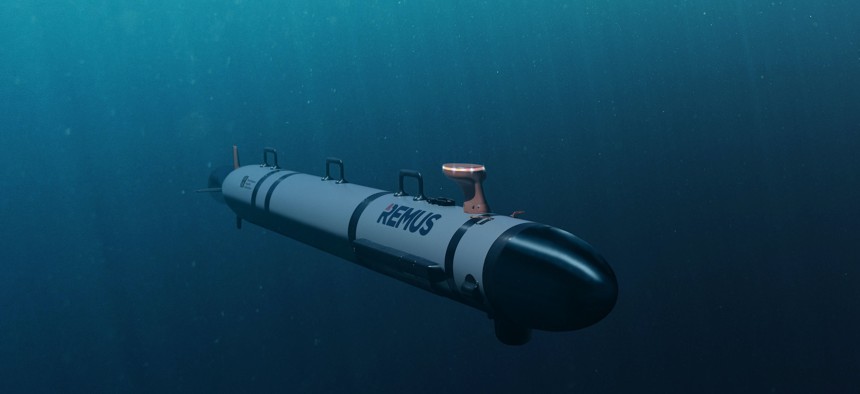Navy Picks HII’s Remus 300 for Lionfish Underwater Drone Program
Pencil-shaped vehicle is built to cooperate with other nearby drones.
The newest Navy diving drone can be carried by two sailors and work with nearby drones to bring a mix of sensors and capabilities to bear on, say, countermine missions.
On March 18, Naval Sea Systems Command announced that it would be sole-sourcing the Huntington Ingalls Industries Remus 300, a seven-foot, pencil-shaped unmanned underwater vehicle. Developed over two years through a Defense Innovation Unit other transaction authority contract, the drone will fill a requirement in the Navy’s Lionfish drone program.
It will replace the Navy’s Mk18 Mod 1 Swordfish, also based on HII’s Remus technology, Duane Fotheringham, the president of unmanned systems in HII’s mission technologies division, told reporters Wednesday.
“We found this process to be extremely valuable,” Fotheringham said. “We heard directly from the sailors and the Marines that are going to be operating our equipment in the field. We were able to incorporate that feedback back into the platforms.”
Fotheringham would not say what types of missions the Navy intends to use the new drone for, but said the most common use for their small and medium drones is for mine countermeasure, one of missions of the Navy’s Mk18 systems. The drone can also be used for intelligence, surveillance, and reconnaissance, surveying, and research, he said.
The Chief of Naval Operations' 2021 Navigation Plan said unmanned platforms will play a “vital role” in its future fleet.
“They will expand our intelligence, surveillance, and reconnaissance advantage, add depth to our missile magazines, and provide additional means to keep our distributed force provisioned. Furthermore, moving toward smaller platforms improves our offensive punch while providing affordable solutions to grow,” it said.
The Navy’s 2022 shipbuilding plan has dozens of unmanned platforms coming into the fleet in the future. The service stood up Task Force 59 to make sure these systems are incorporated quickly into operations.
The Remus 300 is built to operate in concert with other nearby drones. For example, if one drone finds a mine-like object, it can beckon a second drone in for a closer look while the first one moves on, Fotheringham said.
Payloads can be swapped out for missions that need different sensors, and hardware and software kits will allow sailors to develop their own packages. The drone can also swap out batteries and hard drives at sea, eliminating the need to return to shore to extract data or prepare for another mission, Fotheringham said. It can dive to 300 meters, about three times deeper than its predecessor.
HII and the Navy are now negotiating purchase quantities, price, delivery schedule, and training and support services, he said. The company provides its commercial customers a week-long operator course and has other more advanced classes.
HII is currently making the drones at a relatively low rate at its plant in Pocasset, Massachusetts. It aims to deliver the first Remus 300s this summer to other customers, including the New Zealand navy.
“We generally build a lot of the components on the same product lines and share a lot of technology between our commercial and military vehicles. And I think that's one of the advantages of the vehicles, is that all of our customers can take advantage of the developments that we make across the vehicle,” Fotheringham said.
Supply chain problems have been a concern as they establish their production line, he said. Still, there’s no difficulty at the moment in getting key components, and HII is working on long-term agreements with suppliers and plans to keep more components in stock.
NEXT STORY: Pentagon Delays Department-wide Cloud, Again






